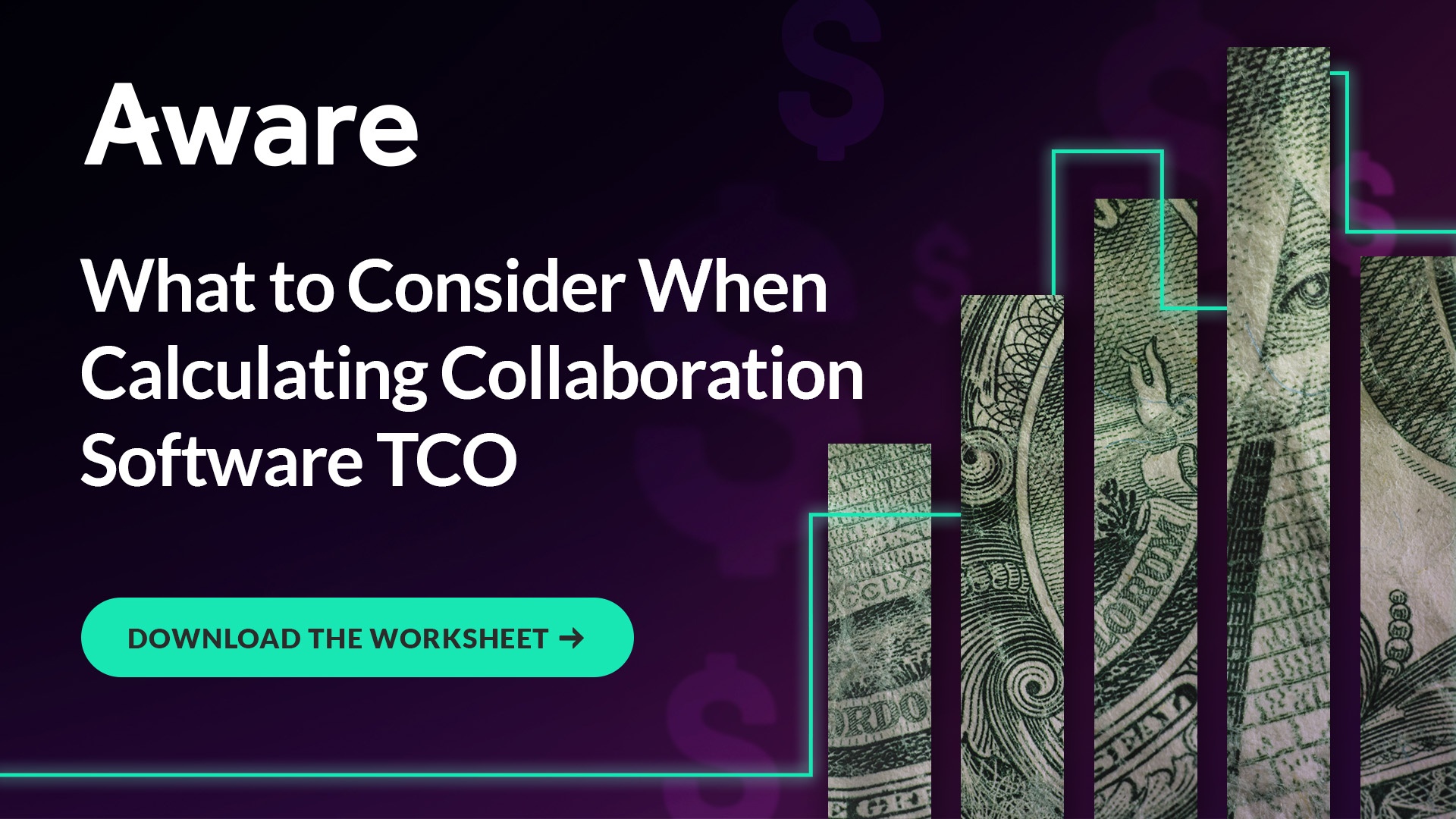What to Consider When Calculating Collaboration Software TCO
by Aware
As an IT leader, you want to provide your organization with tools that enhance productivity without breaking the budget. But how do you establish the total cost of ownership (TCO) of software? Especially if that software doesn’t have a direct impact on revenue.
Studies have long shown that collaboration boosts productivity. Companies that promote collaborative cultures are five times more likely to be high performing. And employees work for 64% longer on team tasks than independent work. That makes implementing a company-wide collaboration platform a smart decision. But how do IT leaders quantify the value of that platform to the organization?
Understanding TCO is critical to gaining a true picture of the cost of your organization's tech stack. It can also help inform decisions between software options by taking a holistic approach to expenditure.
Before making your next major collaboration software investment, here are some of the top factors to consider for determining collaboration software TCO.
What is TCO?
TCO is so much more than the purchase price of software. It’s a review of every attendant cost, from support and training to infrastructure and maintenance. Done correctly, TCO calculations can uncover hidden costs and provide a true picture of the commitment a program requires.
A TCO calculation can be a forward projection or a post-implementation assessment. Ideally, organizations will both project TCO and later review that projection for accuracy. This helps to improve future TCO calculations and maintain true oversight of the impact of new technologies.
TCO vs. ROI
In its simplest form, the calculation for ROI is: (Gain of Investment) - (Cost of Investment) / (Cost of Investment) x 100. That delivers the return as a profit percentage. However, TCO may be preferable to ROI for software. That's because it’s hard to quantify the gain from products and services that don’t directly generate revenue for the organization.
There are other methodologies for calculating if a software investment is worthwhile aside from TCO, but all have their flaws.
- Direct price comparisons between two products that achieve the same goal
This solution fails to consider the cost of implementing the product and training staff. If Option A is cheaper to license but requires a system upgrade and has an extensive learning curve, then pricier Option B may still be the more economical choice.
- A cost analysis of using new software compared with an existing alternative
For examples instead of upgrading your CRM, you could store customer data in Excel. That represents a saving on software costs but doesn’t account for loss of functionality.
- The human cost of different software solutions
Related to the above point, what is the cost to the organization of limiting employee productivity? Your sales team are more valuable closing deals than working on software that slows them down. Giving your employees the tools they need to do their jobs is worth more than the software licensing fees.
- Assessing the cost of failing to implement new technology
Especially important in highly regulated industries. The cost of fines and penalties could far outweigh software TCO. However, while the right software can keep companies compliant and save money in fines, does that equate to value added?
Determining the return on investment of a particular technology can be complex and arbitrary. That’s why many organizations conduct TCO calculations in place of ROI for business software.
Factors That Impact Collaboration Software TCO
The expenses associated with any new technology typically fall into one of three categories: acquisition, operation, and maintenance. Only by identifying all associated expenditures can you accurately determine TCO.
That means considering the type of software products to use and how to deploy them. An off-the-shelf solution makes sense for word processing but not operations management. On-prem server storage could seem like a sound financial decision but become unsustainable as the company scales. And freemium software may cost more than its top SaaS competitor after implementing ancillary programs to facilitate business use.
Collaboration software comes with its own specific requirements and concerns for enterprise users. While the barriers to entry for programs like Slack and Microsoft Teams are relatively low, securing those environments is a challenge. Collaboration tools are built to democratize data, not keep it siloed. That poses risks for DLP and retention, particularly in highly regulated industries.
More Considerations for Collaboration Software TCO
Finding the right software solution is about more than purchasing the cheapest license. It's about finding the product that makes the most sense for your organization.
- How will the business handle data conversion or migrations?
- Are there attendant costs for passive or standby users?
- Will you support and update the software in-house or through a vendor?
- What impact will downtime have on the organization?
- Does the software integrate into existing workflows?
- Will training and onboarding create significant disruption to normal business activities?
All of these questions can impact software TCO across the enterprise. For collaboration software TCO, additional concerns may also be top of mind, including:
- How will collaboration data be managed for GRC?
- What retention policies will apply, and how will they be executed?
- Can you ensure that no sensitive information is shared within the collaboration environment?
- Does the software enable guardrails to detect and prevent harassment?
Final Thoughts
When calculating collaboration software TCO, it’s important to look beyond license fees. Only by taking a holistic view of how that software will function, and what responsibilities the enterprise has to manage collaboration, can IT leaders make informed decisions that limit TCO and provide real returns.
Download our free TCO worksheet to quickly calculate the total cost of your collaboration software solutions.








